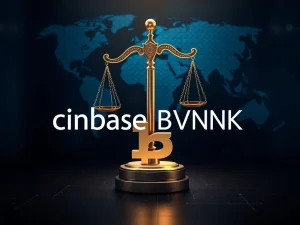BREAKING: Hong Kong Stablecoin Licenses Attract Global Banking Giants HSBC & ICBC

A significant shift is actively unfolding in the global financial landscape as two banking titans, HSBC and the Industrial and Commercial Bank of China (ICBC), reportedly plan to apply for Hong Kong stablecoin licenses. This development marks a pivotal moment for Hong Kong’s ambitions to become a leading digital asset hub. For those closely following cryptocurrency news, this move by traditional financial powerhouses signals growing mainstream acceptance and integration of digital currencies into established banking systems. Furthermore, it underscores the increasing importance of regulatory clarity in fostering innovation.
Global Banking Giants Embrace Hong Kong Stablecoin Licensing
The news, which the Hong Kong Economic Journal initially reported, highlights the serious intent of major financial institutions to engage with the burgeoning stablecoin market. Both HSBC stablecoin and ICBC stablecoin initiatives could reshape how these digital assets are perceived and utilized within the region. ICBC, recognized as the world’s largest bank by total assets, brings immense weight to the stablecoin sector. Meanwhile, HSBC’s involvement further legitimizes the asset class. Neither bank has officially commented on their applications to the Hong Kong Monetary Authority (HKMA) at the time of this report.
This interest emerges as Hong Kong’s new regulatory regime takes effect, creating a structured environment for digital asset operations. Notably, the HKMA indicated it would issue only a limited number of stablecoin licenses initially. Reports suggest that ICBC and Standard Chartered are strong contenders for these first-round approvals. Consequently, they could gain a significant first-mover advantage in a tightly regulated and potentially lucrative market.
Understanding Hong Kong’s Stringent Stablecoin Regulatory Framework
Hong Kong introduced its comprehensive stablecoin regulatory framework on August 1, which included a six-month transition period. This new Stablecoin Ordinance criminalizes the offering or promotion of unlicensed fiat-referenced stablecoins to retail investors. It establishes a notably high bar for entry for prospective issuers. Many applicants, in fact, have described the requirements as stricter than anticipated. This rigorous approach aims to protect investors and maintain financial stability within the special administrative region.
The regulatory guidelines are detailed and extensive. They mandate robust reserve requirements, stringent operational controls, and comprehensive risk management protocols. Furthermore, issuers must demonstrate sound governance and ensure transparent auditing processes. Moreover, these measures are designed to instill confidence in fiat-referenced stablecoins, ensuring their stability and reliability. The goal is to prevent the volatility and collapses seen in less regulated segments of the crypto market.
Impact on the Market: Early Challenges and Corrections
The immediate aftermath of the new rules saw some stablecoin companies operating in Hong Kong experience significant losses. Some firms reported double-digit declines, with values falling as much as 20% in a single day. Local market experts, however, characterized these movements as a healthy correction. This adjustment period effectively purged less compliant or speculative entities, paving the way for more robust and regulated players.
The HKMA’s cautious approach to issuing licenses reflects its commitment to a controlled and secure stablecoin ecosystem. By limiting initial approvals, the authority can closely monitor compliance and market impact. This strategy ensures a measured growth trajectory for the stablecoin sector in Hong Kong. It also allows for iterative improvements to the regulatory framework as the market evolves.
Expanding Hong Kong Crypto Regulation Beyond Stablecoins
The regulatory focus in Hong Kong extends beyond just stablecoins. After establishing clear rules for stablecoin issuance, regulators swiftly turned their attention to cryptocurrency custody standards. In mid-August, the Hong Kong Securities and Futures Commission (SFC) issued immediately effective guidance. These new standards introduced sweeping security requirements for crypto asset custodians. They also implemented a ban on smart contracts in cold wallet implementations, emphasizing security and control.
This holistic approach to Hong Kong crypto regulation aims to build a comprehensive and secure digital asset ecosystem. The SFC’s guidelines mandate advanced cryptographic security, multi-party computation (MPC), and robust internal controls for custody providers. Furthermore, such stringent measures are designed to minimize risks associated with hacking and unauthorized access. They ultimately enhance investor protection across the board. Consequently, the region positions itself as a credible and secure gateway for crypto businesses in Asia.
Navigating the New Regulatory Landscape and Preventing Fraud
The introduction of Hong Kong’s new stablecoin regulatory framework has, unfortunately, also increased the risk of fraud. In mid-August, the SFC issued a warning to investors. Their statement highlighted that heightened speculation surrounding stablecoin news could create opportunities for fraudulent schemes. An official urged investors to exercise extreme caution and avoid making irrational investment decisions. Such decisions are often driven by market hype or price momentum, which can lead to significant losses.
Investors must conduct thorough due diligence before engaging with any stablecoin project or platform. This includes verifying licenses, understanding the underlying technology, and assessing the credibility of issuers. However, regulators actively work to educate the public and identify illicit activities. Individual investor responsibility remains paramount in this evolving market. Staying informed and skeptical are vital defenses against potential scams.
The Future of Stablecoins in Asia: Hong Kong’s Strategic Position
Hong Kong’s proactive and comprehensive approach to stablecoin and broader crypto regulation positions it strategically in the Asian market. The entry of major financial institutions like HSBC and ICBC into the licensed stablecoin space could accelerate adoption. It may also foster greater trust among institutional investors. This development contrasts with mainland China’s more restrictive stance on cryptocurrencies, potentially making Hong Kong a vital bridge for digital finance in the region.
Ultimately, the success of Hong Kong’s stablecoin regime will depend on its ability to balance innovation with robust oversight. The initial strictness, while challenging for some, appears to be attracting serious players. These players prioritize long-term stability and regulatory compliance. As the six-month transition period progresses, the market will closely watch for the first official license issuances. These will undoubtedly shape the future trajectory of stablecoins and digital assets in Hong Kong and beyond.
The commitment to a regulated environment suggests a future where stablecoins play a more integrated role in traditional finance. This integration could facilitate more efficient cross-border payments, enhance liquidity, and introduce new financial products. Hong Kong is actively building a framework that supports this evolution. It aims to harness the potential of digital assets while mitigating inherent risks. This ambitious strategy could solidify its status as a global financial technology leader.







